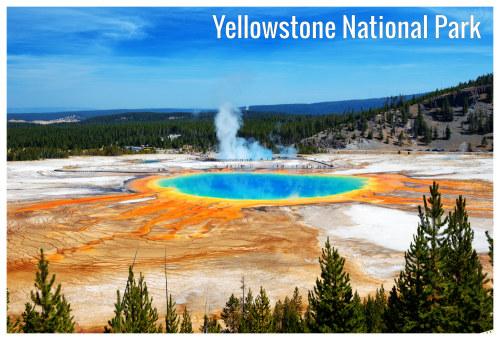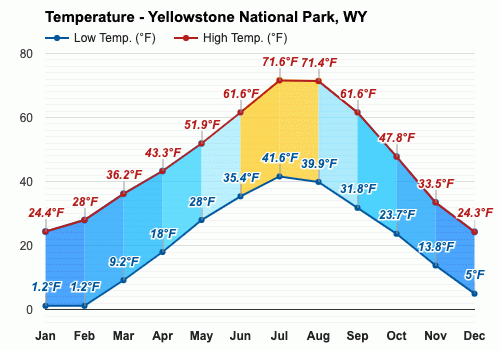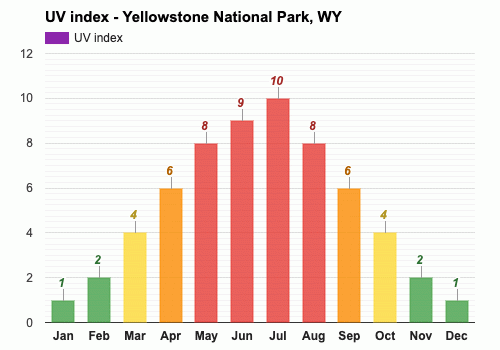Contents
- The climate of Yellowstone National Park
- The best time to visit Yellowstone National Park
- The worst time to visit Yellowstone National Park
- Spring weather in Yellowstone National Park
- Summer weather in Yellowstone National Park
- Autumn weather in Yellowstone National Park
- Winter weather in Yellowstone National Park
- Weather in January
- Weather in February
- Weather in March
- Weather in April
- Weather in May
- Weather in June
- Weather in July
- Weather in August
- Weather in September
- Weather in October
- Weather in November
- Weather in December
- Frequently asked questions
- Average temperature
- Average rainfall
- Average rainfall days
- Average snowfall
- Average snowfall days
- Average daylight
- Average sunshine
- Average UV index

Climate and monthly weather forecast
The climate of Yellowstone National Park
Yellowstone experiences a broad range of temperatures, with the average high peaking at 71.6°F (22°C) in July to a chilling low of 1.2°F (-17.1°C) in February. Interestingly, the average high temperature remains above freezing from April to October, while the mercury drops significantly from November to March. Daylight hours also vary greatly, from a minimum of 8.9 hours in December to a maximum of 15.5 hours in June, mirroring the changing lengths of day and night.
Regarding precipitation, Yellowstone exhibits a balanced pattern, albeit with some fluctuations. The number of rainfall days varies slightly across the year, from a low of 8.8 days in October to a high of 16.8 days in January. The total rainfall follows a similar distribution, from a low of 1.2" (30mm) in October to a high of 2.5" (64mm) in May. Snowfall is substantial between November and March, with no snow observed from June to September.
An interesting pattern lies in the UV index. A low of 1 is detected in the winter months, December and January, and climbs gradually to reach a high of 10 in July, reflecting the movement and intensity of the sun.
The best time to visit Yellowstone National Park
The worst time to visit Yellowstone National Park
Spring weather in Yellowstone National Park
Summer weather in Yellowstone National Park
Autumn weather in Yellowstone National Park
Winter weather in Yellowstone National Park
Weather in January
Weather in February
Weather in March
Weather in April
Weather in May
Weather in June
Weather in July
Weather in August
Weather in September
Weather in October
Weather in November
Weather in December
Published by: Weather U.S. | About Us
Data Sources | Weather Forecasting & Climate
Frequently asked questions
How much does it rain in Yellowstone National Park?
When does it snow?
When does it snow the most?
How many days does it snow in Yellowstone National Park?
What is the month with the lowest UV index?
When is Daylight Saving Time (DST)?
What is the wettest month?
When are the longest days?
What are the warmest months?
When it does not snow?
What month has the most sunshine?
When is the highest UV index?
What is the driest month?
What part of the year is the coldest?
What is the month with the shortest days?
What is the month with the least sunshine?

Average temperature
Yellowstone National Park, WY
The warmest month (with the highest average high temperature) is July (71.6°F).
The month with the lowest average high temperature is December (24.3°F).
The month with the highest average low temperature is July (41.6°F).
The coldest months (with the lowest average low temperature) are January and February (1.2°F).

Average rainfall
Yellowstone National Park, WY
The wettest month (with the highest rainfall) is May (2.5").
The driest month (with the least rainfall) is October (1.2").

Average rainfall days
Yellowstone National Park, WY
- Average rainfall days in January:
16.8 days - Average rainfall days in February:
14 days - Average rainfall days in March:
13.7 days - Average rainfall days in April:
11.6 days - Average rainfall days in May:
11.5 days - Average rainfall days in June:
14.4 days
- Average rainfall days in July:
11 days - Average rainfall days in August:
10.8 days - Average rainfall days in September:
9.7 days - Average rainfall days in October:
8.8 days - Average rainfall days in November:
13.1 days - Average rainfall days in December:
15.6 days
The month with the highest number of rainy days is January (16.8 days).
The month with the least rainy days is October (8.8 days).

Average snowfall
Yellowstone National Park, WY
- Average snowfall in January:
34.3" - Average snowfall in February:
30.4" - Average snowfall in March:
25.6" - Average snowfall in April:
21.4" - Average snowfall in May:
8.1" - Average snowfall in June:
1.3"
The month with the highest snowfall is January (34.3").
The months with the least snowfall are July and August (0").

Average snowfall days
Yellowstone National Park, WY
- Average snowfall days in January:
16.2 days - Average snowfall days in February:
13.4 days - Average snowfall days in March:
12.6 days - Average snowfall days in April:
9.5 days - Average snowfall days in May:
4.4 days - Average snowfall days in June:
0.9 days
- Average snowfall days in July:
0 days - Average snowfall days in August:
0 days - Average snowfall days in September:
1.1 days - Average snowfall days in October:
5.8 days - Average snowfall days in November:
12.6 days - Average snowfall days in December:
14.9 days
The month with the highest number of snowfall days is January (16.2 days).
The months with the least snowfall days are July and August (0 days).

Average daylight / Average sunshine
Yellowstone National Park, WY
- Average daylight in January:
9h and 2min - Average daylight in February:
10h and 3min - Average daylight in March:
12h and 0min - Average daylight in April:
13h and 3min - Average daylight in May:
14h and 5min - Average daylight in June:
15h and 3min
- Average daylight in July:
15h and 1min - Average daylight in August:
14h and 0min - Average daylight in September:
12h and 3min - Average daylight in October:
11h and 0min - Average daylight in November:
9h and 4min - Average daylight in December:
8h and 5min
The month with the longest days is June (Average daylight: 15h and 30min).
The month with the shortest days is December (Average daylight: 8h and 54min).
The month with the most sunshine is July (Average sunshine: 11h).
The month with the least sunshine is December (Average sunshine: 4h).

Average UV index
Yellowstone National Park, WY
The month with the highest UV index is July (UV index 10).
The months with the lowest UV index are January and December (UV index 1).